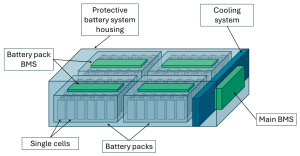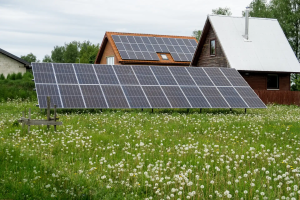Heated lithium battery: Offers warmth and energy during the winter?
Summer isn’t always the worst season to get ready for winter. You might want to think about heating your lithium battery if you intend to travel or live off the grid during the winter.
There are many different sizes and types of lithium batteries, and some are more suited to colder climates than others. Lithium iron phosphate (LFP) batteries, for instance, are renowned for their longevity, safety, and thermal stability. Investing in a high-quality battery with integrated heating can ensure that you have power during the lowest temperatures.
Your mobile lifestyle depends on your battery. However, low temperatures can impact the charge, functionality, and lifespan of all batteries, regardless of the type of vehicle you drive. You can stay powered throughout the winter by being aware of the significance of battery kits and how they guard against battery deterioration in low temperatures.
Let’s examine how battery life and performance are impacted by frigid conditions. We’ll also include advice on how to choose and use batteries in chilly climates.

How does the battery's capacity to store and release energy change with the temperature?
The reduction in energy transfer without a heated battery pack will lower the battery’s capacity, performance, and service life, which will have an impact on the battery’s efficiency. This occurs for a number of reasons:
The battery’s internal chemical processes slow down and produce less current when it’s chilly outside.
The battery’s internal resistance rises as the voltage output falls.
The battery’s electrolyte solution thickens and loses some of its conductivity.
Because they react more slowly, have higher resistance, and have lesser conductivity at low temperatures, most batteries do not release or hold charge well.
The same charging current cannot be used by lithium batteries when the temperature falls below freezing (32°F). Additionally, charging these batteries when the gadget is below freezing is risky.
Consider it this way: Your body needs time to acclimate to the cold. This also applies to your battery. You wouldn’t just go outside and start working in a snowstorm, would you?
First of all, a battery has a maximum number of charge cycles that it can tolerate.
First of all, a battery has a maximum number of charge cycles that it can tolerate. They wear down more quickly the more charge cycles they receive. Usually, lead-acid batteries are only good for 400 cycles. On the other hand, lithium deep cycle batteries have a 3,000–5,000 cycle life. The inability to charge batteries in cold weather is another issue. In general, charging lithium-ion batteries in below-freezing temperatures is not accepted. Lead-acid batteries can be recharged, although the process is extremely slow.
For instance, the internal battery management protection system of Maxworld Batteries’ heated battery kits stops the battery from charging when the outside temperature falls below 25°F. Furthermore, charging is only possible when the outside temperature rises above 32°F (0°C). The key to keeping the battery safe is the battery management system (BMS). They also use low-consumption technology to stay warm and ready to charge.
Lead-acid AGM batteries can charge at lower temperatures since they lack this protection mechanism, but there is a chance that the battery may sustain irreversible damage. Nevertheless, many people believe that lead-acid batteries are a superior power supply alternative because they can charge (slowly) in extremely cold conditions. It is untrue.
Why using heated lithium batteries is a good idea?
The main component of outdoor equipment is a battery. As a result, you must take every precaution to guarantee their longevity. Let’s examine why heated lithium batteries are the most suitable option for tourists in chilly climates.
Improved performance
There is a widespread misperception that lithium batteries don’t work well in cold climates. They really outperform all other battery types, quite the reverse. Nevertheless, subjecting them to high temperatures can still be harmful. For this reason, heated lithium-ion batteries are essential in environments with low temperatures.
The source of this fallacy is battery abuse. When the battery was attempted to be charged in an overly cold environment, internal short circuits and battery failure resulted. In this instance, it won’t charge even though it will still function.
Lithium batteries that are heated are shielded from charging in below-freezing conditions. A combat-grade battery, for instance, will deplete to -4°F. However, the BMS takes over and stops them from charging when the temperature falls below 25°F.
Longer lifespan
Your heated lithium battery will outlast a lead-acid battery by far thanks to its superior performance. While all batteries are impacted by lower temperatures, lithium-ion batteries perform better in colder climates.
A longer service life translates into lower replacement and repair expenses. Ultimately, your lithium-ion battery will outlast lead-acid batteries if you give it the care and maintenance it needs.
More lightweight
Weight might become a serious problem as the temperature drops. Traveling in chilly weather gets harder the more stuff you have to carry. Lead-acid batteries weigh around half as much as lithium batteries. As a result, they are simpler to transport for travelers who are visiting far-flung locations in the winter.
Improved provision of energy
When utilized with heavy loads at any temperature, lithium batteries offer good input energy feedback. Consequently, you can charge the battery without being concerned that it would run out of juice after a few chilly hours.
In large part, this is dictated by Puckett’s law, which explains how a rechargeable lead-acid battery’s capacity changes at certain discharge rates. Because of internal resistance and chemical losses, a battery essentially loses energy faster than it gains.
Because they may be completely depleted without losing functionality, lithium batteries have shown to be superior in this regard.
Charging conveniently
Many lead-acid batteries lose their usefulness in cold weather. Lithium batteries can still charge and function in the interim, particularly hot ones. Nevertheless, the built-in BMS will shield the battery from overcharging and potential damage in extremely low temperatures.
There is no internal BMS in lead-acid batteries. They impose fees even when they shouldn’t. Battery deterioration will occur more quickly the more of these occur. Even if you do gain a little power today, will it really be worth losing your battery forever tomorrow?
How can a heated battery kit assist with power maintenance in chilly weather?
Not only does the battery’s performance drop in cold weather, but its ability to charge also suffers. In order to ensure dependable operation and avoid freezing, cracking, and long-term damage, batteries must be protected from the cold. For any outdoor activity where the battery may be exposed to extremely cold temperatures, heated battery kits are strongly advised.
A heated battery kit stops internal chemical reactions from slowing down by heating the battery. This increases the battery’s capacity over time and enhances its ability to charge and power.
The battery is heated by the heating element, and its ideal temperature is maintained by the temperature controller. By doing this, damage from overheating and loss of energy from the cold are avoided.
One example of a patented low-consumption technology that keeps the battery at the ideal temperature and ready for charging is found in Maxworld Power’s deep-cycle LiFePO4 heated batteries. When the temperature drops below 35°F, these units automatically turn on, and when it rises above 45°F, they automatically turn off.
How to select and utilize a hot battery kit for your vehicle?
There are various things to think about while selecting a heated battery kit, including:
Size: Verify that the size and type of the heater battery kit are appropriate for the planned use.
Battery Capacity: Longer usage times are possible with higher capacity batteries.
Charge time: Verify the highest possible current for both charging and draining. Lithium batteries can be charged to more than 95% capacity in roughly two hours, whereas lead-acid batteries can take up to ten hours.
Verify that the kit and the item you wish to power are compatible.
Safety Features: To preserve your safety and battery life, get a kit with thermal protection.
Warranty: Five or even ten years are offered by certain hot battery packs.
Cycle life: LiFePO4 batteries may typically be used 3,000–5,000 times, which is a considerably longer cycle life than lead-acid batteries.
Installation Accessories: Verify that the extra wires or cables required for installation are included in your order.
Advice on how to use a kit of hot batteries
You can maximize the performance of your heated battery pack by following these tips:
- Make sure you adhere to the manufacturer’s installation guidelines.
- For details on battery maintenance, consult the manufacturer’s handbook.
- Batteries should be kept indoors in a dry, insulated location away from extremely hot or cold conditions while not in use.
- Keep an eye on the heated battery pack’s voltage and temperature, and adjust as needed.
- Even if the battery is waterproof, try to keep it dry.
- Keep your batteries tidy.
Conclusion
This winter, heated lithium batteries will come in useful. Despite what the general public believes, they function well in cold weather. That’s not to mean you can just toss them in the snow and hope they start producing power. It takes care to keep batteries functioning. If you’re willing to work with them, they will work for you.
Lithium batteries continue to be the best choice for powering winter outdoor activities, even if low temperatures can influence the performance of any battery. You may prolong and improve your time spent off the grid by upgrading to a heated battery pack.
Cold circumstances are easier to deal with when using Maxworld batteries. An integrated BMS ensures optimal performance in all weather conditions for its heated lithium battery. They will ensure that your boat, RV, or off-grid dwelling doesn’t freeze in the winter.






